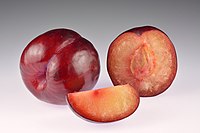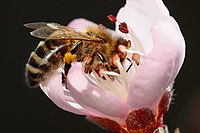
COMPARATIVE STUDIES ON THE PHYSIOCHEMICAL PROPERTIES, PHENOLIC COMPOUNDS AND ANTIOXIDANT ACTIVITIES IN 13 JAPANESE PLUM CULTIVARS GROWN IN THE SUBTROPICAL REGION OF CHINA
Sign Up to like & getrecommendations! Published in 2020 at "Applied Ecology and Environmental Research"
DOI: 10.15666/aeer/1802_31473159
Abstract: The physiochemical parameters and antioxidant properties of plum cultivars, grown in subtropical regions of China are little known. However, in this comparative study, these properties of 6 landraces and 7 introduced cultivars showed evaluated. The… read more here.
Keywords: cultivars grown; japanese plum; plum cultivars; grown subtropical ... See more keywords

Genotyping by Sequencing for SNP-Based Linkage Analysis and Identification of QTLs Linked to Fruit Quality Traits in Japanese Plum (Prunus salicina Lindl.)
Sign Up to like & getrecommendations! Published in 2017 at "Frontiers in Plant Science"
DOI: 10.3389/fpls.2017.00476
Abstract: Marker-assisted selection (MAS) in stone fruit (Prunus species) breeding is currently difficult to achieve due to the polygenic nature of the most relevant agronomic traits linked to fruit quality. Genotyping by sequencing (GBS), however, provides… read more here.
Keywords: prunus; quality traits; japanese plum; fruit ... See more keywords

Characterization of Japanese Plum (Prunus salicina) PsMYB10 Alleles Reveals Structural Variation and Polymorphisms Correlating With Fruit Skin Color
Sign Up to like & getrecommendations! Published in 2021 at "Frontiers in Plant Science"
DOI: 10.3389/fpls.2021.655267
Abstract: The red to blue hue of plant organs is caused due to anthocyanins, which are water-soluble flavonoid pigments. The accumulation of these pigments is regulated by a complex of R2R3-MYB transcription factors (TFs), basic-helix-loop-helix (bHLH),… read more here.
Keywords: prunus salicina; color; japanese plum; variation ... See more keywords

Pollen-Pistil Interaction in Response to Pollination Variants in Subtropical Japanese Plum (Prunus salicina Lindl.) Varieties
Sign Up to like & getrecommendations! Published in 2022 at "Plants"
DOI: 10.3390/plants11223081
Abstract: The Japanese plum (Prunus salicina Lindl.) is a fruit tree globally cultivated in temperate regions of the world. Its floral biology and yield are affected by several factors, with issues related to self- and cross-… read more here.
Keywords: pollination; fruit set; japanese plum; satluj purple ... See more keywords